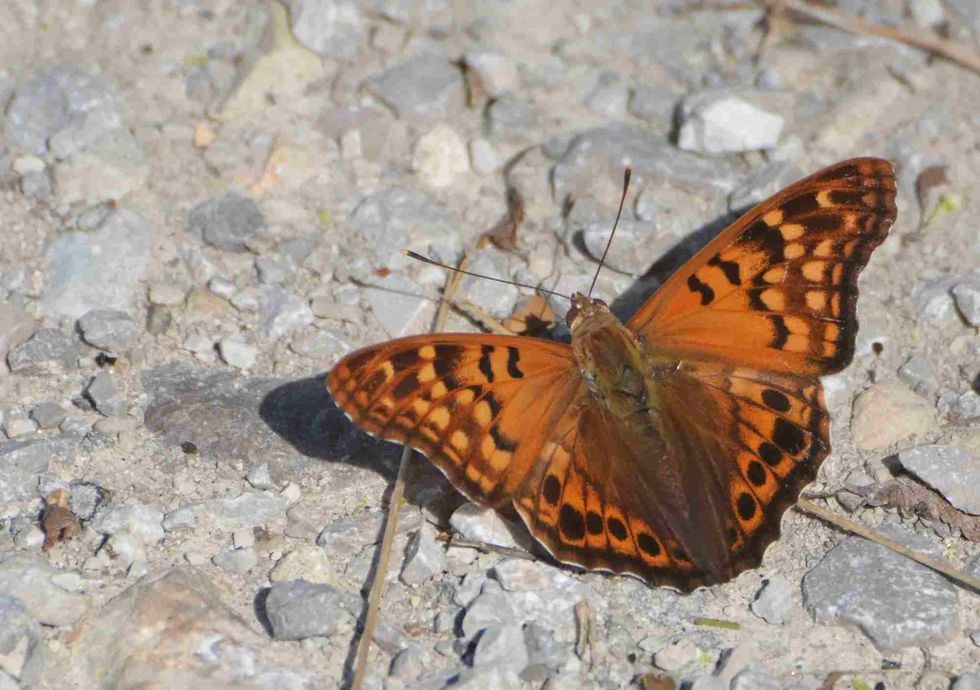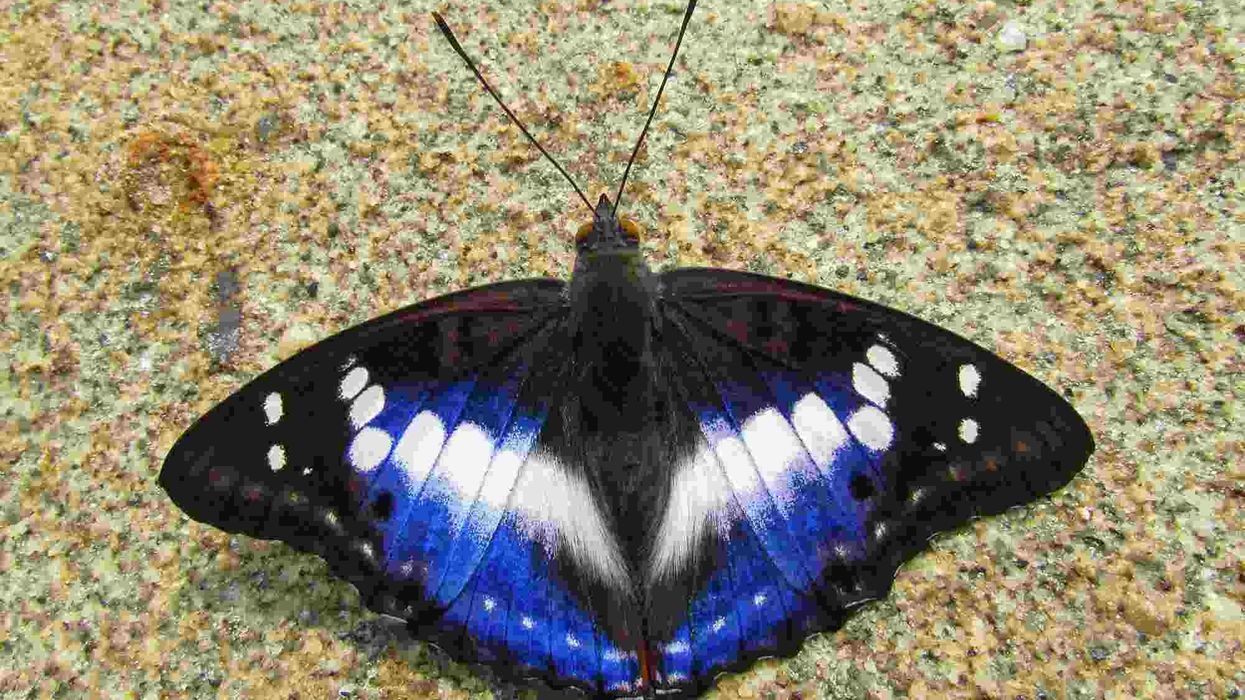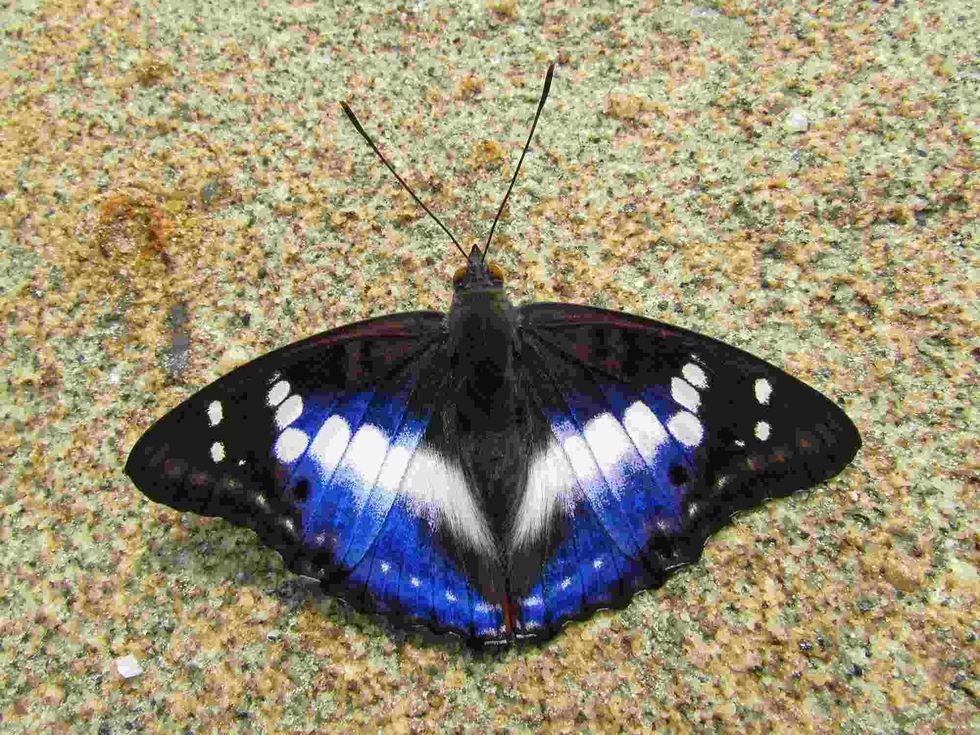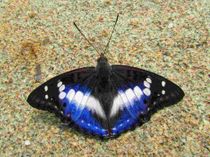Fun Emperor Butterfly Facts For Kids

Emperor butterflies, sub-family of Aparturinae and Charaxes, are beautiful insect species that belong to the order of Lepidoptera and family Nymphalidae. They have beautiful hind wings and fore wings, which help to identify the male and female butterfly. Sexual dimorphism exists in them. Many emperor butterflies are evident with their iridescent nature.
Aparturinae is a sub-family that mostly consists of emperor butterflies, such as the purple emperor butterfly (Apatura iris), tawny emperor butterfly (Asterocampa clyton), Japanese emperor, or great purple emperor butterfly (Sasakia charonda), and white emperor butterfly (Helcyra hemina). The orange emperor butterfly (Charax laton) and the tailed emperor butterfly (Polyura sempronius) belong to the sub-family of Charaxes.
Globally, they can be found in southern England, East Asia, West Australia, and South-North America in woodland. Most of them are evident during the summer or by the end of the summer season, in June or July.
However, the number of emperor butterflies is declining at a faster rate and many wildlife protection acts have been incorporated in order to protect them. The purple emperor butterfly has significant meaning in the lives of people.
If you are interested in butterflies, check out some interesting facts about the purple emperor butterfly facts and the hackberry emperor butterfly fun facts.
Emperor Butterfly Interesting Facts
What type of animal is an emperor butterfly?
The emperor butterfly belongs to the family Nymphalidae. Emperor butterflies commonly belong to the subfamily of Aparturinae and Charaxes. Lepidoptera is the order of their scientific history. The scientific name for the category of emperor butterfly is still unclear and not known.
What class of animal does an emperor butterfly belong to?
Emperor butterflies are beautiful, vibrant butterflies with wide wings that belong to the class of Insecta and many genera such as Apatura, Sasakia. The Apatura genus was founded by the Danish zoologist, Johan Christian Fabricius, in 1807. Apatura mainly consists of emperor butterflies, such as Apatura iris (purple emperor butterfly), Apatura ilia (lesser purple emperor butterfly).
How many emperor butterflies are there in the world?
There are many different types of emperor butterflies around the world, few are rare, while the rest are not.
The Wildlife and Countryside Act of 1981 and the Wildlife Protection Act of 1972 have taken many steps towards the preservation of the purple emperor butterfly and white emperor butterfly, respectively, as their numbers are declining in comparison to past records.
For example, the male purple emperor butterfly (Apatura iris) is now only restricted to central-southern England. The white emperor butterfly is also few in number in India, Bhutan.
Where does an emperor butterfly live?
The emperor butterflies are global wildlife natives from south to west. Purple emperor butterflies and lesser purple emperor butterflies are found in different parts of central-southern England.
The Japanese emperor butterflies are found in China and northern parts of Taiwan and Vietnam. The white emperor butterflies are found in Sikkim and Assam (India). The tailed emperor are famous for their horns and the orange emperor butterflies are found in parts of Australia.
What is an emperor butterfly's habitat?
The emperor butterfly habitat varies from each other.
For example, purple emperor butterflies live in deciduous woodland similarly to the habitat of the regal moth; tailed emperor butterflies live in the subtropical coastal regions of Australia; Japanese emperor butterflies live in the upper canopies of the forest and only come down for food; orange emperor butterflies live in the rainforest; tawny emperor butterflies live in dry woods.
So, the habitat of emperor butterflies is not specific to a particular place due to their geographical location.
Tall trees with green leaves, such as oak, dry woods with willow, trunks of sugarberry, and wood logs are ideally preferred places for them to stay. The adult male emperor butterfly can be spotted in tall trees, whereas females can be spotted mostly in ground-level green vegetation. The summer season is more evident with the larvae stage.
Who do emperor butterflies live with?
The emperor butterfly eggs are laid in groups of 75-100, specifically, purple emperors lay eggs in 100. The young baby emperor butterfly caterpillar lives in groups for food.
In groups, they help each other to reach food resources through silk trails. When they reach their fourth and fifth instar stage, they isolate themselves and take shelter mostly under green leaves to protect themselves from predators. The ghost moth lays more eggs in comparison to the emperor butterfly.
How long does an emperor butterfly live?
The life span of the emperor butterfly is one to six months. It depends upon the surroundings the butterflies are living in.
For example, if they are living in their optimal condition, then they survive for a longer period of time, but if they do not get good surroundings for living, then they live for a shorter period of time. An adult survives for a shorter duration, if not kept under optimal conditions same as the gypsy moth.
How do they reproduce?
Adult males are spotted near tall trees and are elusive by nature. When they have to mate, they are usually attracted by sexual pheromones released by females, specifically, if they fly at night and have to mate, or females spread their wings, showing body gestures in order to woe the male butterfly.
In short, physical gestures, pheromones, and the behavior of females help males to identify the right partner to mate with.
After mating, the eggs are laid on the food plants, which are generally preferred to be eaten by larvae. Some emperor butterflies lay eggs on the upper side, while others underneath the mature leaves of the plant wherever it is shadier and darker, such as dry willow, oak trees, and sallow leaves.
It is done to protect the eggs from parasites and small animals around them.
What is their conservation status?
Although they are found globally, few emperor butterflies, such as purple emperor butterflies, white emperor butterflies, are declining in number. Some steps have been taken in order to conserve them. So, the conservation status of the emperor butterflies is of Least Concern.
Emperor Butterfly Fun Facts
What do emperor butterflies look like?
Emperor butterflies are well known for their iridescent colors. Yellow, orange, blue, gray, black and white.
Female emperor butterflies are larger in size in comparison to males. Males and females of both species have hind wings and fore wings with dark-spotted eyes.
The upper wings are light in color, whereas, the lower wings have color variations from blue to black, white to gray, brown to pale orange with yellow, white, black, dark, or light spots on them.
They have furry and smooth antennas. Some emperor caterpillars have horns on their heads.
Purple emperor butterfly wings are blue-black in color with a furry dark brown thorax and abdomen. The male purple is more beautiful in comparison to the female purple emperor. The female emperor is brown-tan orange in color.
The female purple emperor has larger wings than the male purple emperor. Unlike the upper wing, the under wing does not have dark spots. The green pupa of the purple emperor is known as chrysalis and camouflage like willow and sallow leaves.

How cute are they?
The emperor butterfly is a beautiful species that has significant meaning within itself. Their iridescence makes them brighter and more vibrant. A nature lover would love to see them and become vibrant like them.
The emperor butterflies are as colorful and joyful to see as the flowers. Even the green pupa of the purple emperor is very beautiful. Adult emperors are the cutest because of their colorful wings.
How do they communicate?
They generally communicate by physical gestures, such as color, the spreading of wings to identify the same species, behavior, and scent, known as pheromones, which further helps them identify and communicate within the same species, as parasites can be dangerous for them.
How big is an emperor butterfly?
They have a wide wingspan of 2-3.5 in (5-9 cm). In central-southern England, purple emperors are considered among the second-largest butterflies. The female emperor butterfly wingspan is around 3.15-3.54 in (8-9 cm), whereas the male purple butterfly wingspan is around 2.8-3 in (7-7.6 cm). The larvae of the purple emperor butterfly are 1.5 in (4 cm) long.
How fast can an emperor butterfly fly?
There is no specific evidence on how fast they can fly. Male emperors fly faster in comparison to females. Their lightweight allows them to fly high and fast along with the wind flow.
How much does an emperor butterfly weigh?
Ideally, they are very light in weight. Their average weight is 0.07-0.1 oz (2-3 g), which enables them to fly along with the wind flow at higher altitudes so that they can protect themselves from their predators.
What are the male and female names of the species?
There are no specific names given to the female and male species, but the male purple emperor butterflies are known by the name 'his imperial majesty' because of their iridescent colors with glimmering shine on their wings, whereas, the female purple emperor butterflies are called 'her majesty'.
What would you call a baby emperor butterfly?
Baby emperor butterflies are called young larvae that hatch out of the eggs. They prefer to stay in a group in order to feed themselves through the silk trails. Later, they turn out to become the caterpillar, pupa, and adult emperor butterflies.
What do they eat?
The emperor butterfly feeds on honeydew, tree sap, especially sap from oak trees, larvae, rotting fruits, dung, black locust, hackberries. They are omnivores and eat both plants and rotten dead decay. Adults of the purple emperor feed on moisture from dung, rotten fruits, and larvae. They are omnivores, while the puss moths are herbivores.
Are they dangerous?
No, emperor butterflies are not dangerous, but few cases of tawny emperor butterflies have been reported in Israel. Parasitic insects and predators have helped out by removing them. Parasitic insects mostly prey on their pupa and young larvae.
Would they make a good pet?
Yes, they would make a good pet. Though the site of an adult emperor might lure us, we should leave them in their own wildlife space. This allows them to grow naturally in willow, oak, sallow, and woods. It is better to site them in the open sphere under tall trees.
Did you know...
The scientific name of the purple emperor butterfly, Apatura iris, has a significant meaning. The word 'Apatura' has been derived from Greek terminology, which means 'one who is full of deceitfulness'. The beautiful, vibrant color of purple emperor butterflies is named scientifically so because of their enigmatic nature. Iris is the Greek goddess of the rainbow.
The purple emperor butterflies have five subspecies, Apatura iris iris, Apatura iris bieti, Apatura iris xanthina, Apatura iris kansuensis, and Apatura iris amurensis.
The blue emperor butterfly (Morpho peleides kollar) helps with pollination. Unlike other emperor butterflies, the blue emperor butterflies are herbivores and drink the juices of tree sap, fungi.
The Japanese emperor butterfly is the national butterfly of Japan since 1957.
The emperor butterfly symbolizes different meanings in different cultures. The features of different emperor butterflies exposit colors, rejoice, joy, and change in luck. In a dream, it symbolizes guidance by angels to know how special you are.
Types of emperor butterfly
There are various types of emperor butterfly, purple emperor butterflies (Apatura iris), tawny emperor butterfly (Asterocampa clyton), Japanese emperor or great purple emperor butterflies (Sasakia charonda), white emperor butterfly (helcyra hemina), hackberry emperor butterfly (Asterocampa celtis), orange emperor butterfly (Charax laton) and tailed emperor butterfly (Polyura sempronius).
Emperor vs monarch butterfly
The caterpillar stage of the monarch butterfly can be dangerous for their predators because of their feeding habits, as they feed on some of the poisonous toxins of milkweed, whereas the emperor butterfly is not poisonous. The monarch butterflies are larger in size at 3-4 in (8-10 cm), whereas, the emperor butterflies are smaller in size.
Monarch butterflies are herbivores, while emperor butterflies are omnivores.
Here at Kidadl, we have carefully created lots of interesting family-friendly animal facts for everyone to discover! For more relatable content, check out these morpho butterfly interesting facts and monarch butterfly fun facts pages.
You can even occupy yourself at home by coloring in one of our free printable emperor butterfly coloring pages.
We Want Your Photos!
More for You
Bachelor of Arts specializing in English, Bachelor of Education specializing in Secondary Education and Teaching, Master of Arts specializing in English

Anamika BalouriaBachelor of Arts specializing in English, Bachelor of Education specializing in Secondary Education and Teaching, Master of Arts specializing in English
Bachelor of Commerce specializing in Marketing and HR

Pradhanya RaoBachelor of Commerce specializing in Marketing and HR
With a Bachelor’s degree in Commerce from Christ University, Bangalore, Pradhanya's passion for the English language and literature led her to explore the field of content writing, where she has gained extensive experience in writing, reviewing, editing, and fact-checking. She has also earned certifications in Google Ads Search, Google Ads Display, and Social Media Marketing, showcasing her proficiency in digital marketing.
Disclaimer
1) Kidadl is independent and to make our service free to you the reader we are supported by advertising. We hope you love our recommendations for products and services! What we suggest is selected independently by the Kidadl team. If you purchase using the Buy Now button we may earn a small commission. This does not influence our choices. Prices are correct and items are available at the time the article was published but we cannot guarantee that on the time of reading. Please note that Kidadl is a participant in the Amazon Services LLC Associates Program, an affiliate advertising program designed to provide a means for sites to earn advertising fees by advertising and linking to Amazon. We also link to other websites, but are not responsible for their content.
2) At Kidadl, we strive to recommend the very best activities and events. We will always aim to give you accurate information at the date of publication - however, information does change, so it’s important you do your own research, double-check and make the decision that is right for your family. We recognise that not all activities and ideas are appropriate for all children and families or in all circumstances. Our recommended activities are based on age but these are a guide. We recommend that these ideas are used as inspiration, that ideas are undertaken with appropriate adult supervision, and that each adult uses their own discretion and knowledge of their children to consider the safety and suitability. Kidadl cannot accept liability for the execution of these ideas, and parental supervision is advised at all times, as safety is paramount. Anyone using the information provided by Kidadl does so at their own risk and we can not accept liability if things go wrong.
3) Because we are an educational resource, we have quotes and facts about a range of historical and modern figures. We do not endorse the actions of or rhetoric of all the people included in these collections, but we think they are important for growing minds to learn about under the guidance of parents or guardians.







